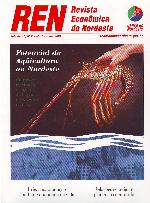ECONOMIA AGRÍCOLA, ECOFISIOLOGIA E RELAÇÕES SOLO-ÁGUA-PLANTA NO SEMI-ÁRIDO NORDESTINO: A OPÇÃO ALGODÃO
DOI:
https://doi.org/10.61673/ren.2001.1822Keywords:
Regional development, Cotton Systems, Agroecosystem, Irrigation, Rainfall ConditionsAbstract
The present paper discuss the biotope of the semi-arid region giving emphasis in the ecophisiology and soil-water-plant relationships, “biocenose” elements. In enphasizes the occasional problems caused by soil and climate conditions, especialy the high temperature, solar radiation in that region and the possibility to make it maintainable take in the cotton as herbaceous (Gossypium hirsutumn L.r. latifolium Hutch) as the perennial (Gossypium spp) and syntetic hybrids such as 7MH cotton, in the context of semi-arid of Northeast Brazil, species and races with wide sucess possibility, in view of the great fenotipic variability that it has. In the region, there are more than three millions and five hundred thousand irrigable hectares where the cotton in a real profitable and maintainable option, and more than 29 millions of available hectares (19% of the total area) in rainfall conditions. Through of the use of new technologies such as precocious cultivars, pest control alternatives, low disease incidence due the hot and dry climate, and better cultural management, it is possible to produce cotton with profitability and exceptional quality, one of the best of the world. Abnd besides it is possible to create thousands employments and to help the better regional income distribution.








